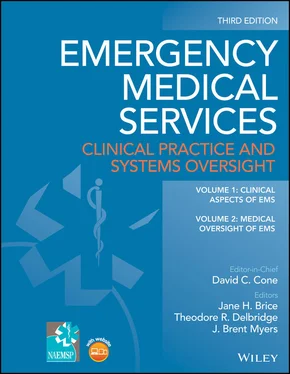As early as 1970, DOT and the ACS had developed ambulance design and equipment recommendations [48, 49]. In 1973, DHEW released the comprehensive guide, Medical Requirements for Ambulance Design and Equipment , and a year later the U.S. General Services Administration issued federal specifications KKK‐A 1822 for ambulances [50]. Although the KKK specifications were originally developed for government procurement contracts, local EMS agencies were often politically obligated to meet or exceed the specifications when ordering new ambulances. A 1978 study described the status of ambulance services within 151 of the regions. Only 65% of the 13,790 ambulances in those regions met the federal KKK standards. Eighty‐one regions used paramedics and 72 had some type of air ambulance capability. Response time was often longer than 10 minutes in urban areas and as much as 30 minutes in rural areas [51].
When awarding grants for EMS under the EMS Systems Act, DHEW required regions to develop standards and guidelines for categorization of emergency departments in the following eight critical clinical groups: trauma, burns, spinal cord injuries, poisoning, cardiac, high‐risk infants, alcohol and drug abuse, and behavioral emergencies. Regions were required to identify the most appropriate receiving hospitals for each of these clinical problems.
In reality, only a small portion of emergency facilities was functionally categorized, and in many cases the system did not work as described on paper. Hospital administrators resisted losing control, physicians feared surrendering clinical judgment, and both feared losing patient revenues. Despite this resistance, DHEW used EMS hospital categorization to restructure acute patient distribution along the lines of clinical capability rather than market share.
1978–1981: EMS at Midpassage
By 1978, many of the original problems and questions concerning EMS had come into focus. Many of the deficiencies identified in the 1966 NAS‐NRC report had been addressed, and progress was being made in many areas. Economic resources and political support were being contributed by local and state governments, private foundations, non‐profit organizations, and professional groups. However, there was still tremendous geographic variability regarding access to and distribution of services and accessibility, quality, and quantity of EMS resources. Basic questions concerning the effectiveness of the various components, system designs, and relationships still existed, and future funding was uncertain.
In 1978, the NAS‐NRC released Emergency Medical Services at Midpassage, which stated, “EMS in the United States in midpassage [is] urgently in need of midcourse corrections but uncertain as to the best direction and degree.” The report was sharply critical of how the EMS Systems Act had been implemented by DHEW and recommended “research and evaluation directed both to questions of immediate importance to EMS system development and to long‐range questions. Without adequate investment in both types of research, EMS in the United States will be in the same position of uncertainty a generation hence as it is today” [52]. The report documented coordination problems among various governmental agencies, focusing particular concern on the multiple standards promulgated as a condition of funding. Some of the standards were conflicting; often they had never been evaluated [52].
Between 1974 and 1981, there were various sources of federal and private funds, and each grant often came with a new set of requirements. DOT established standards for ambulance design, personnel training, and other transportation elements, and DHEW announced seven critical care areas as the basis for a systems approach and 15 components as modular elements for EMS design. A variety of private organizations also produced standards. With regard to the technique of CPR, the American Red Cross and the AHA established slightly different standards, criteria, and training requirements. By 1978, some states still had not enacted EMS legislation, whereas others had legislated specifically what prehospital clinicians could do, potentially hampering the flexibility needed for successful local development. Lack of national conformity or agreement precluded the development of universally accepted national standards in most areas of EMS.
On 26 October 1978, a memorandum of understanding was signed by DOT and DHEW describing each organization’s responsibilities relating to development of EMS systems. The agreement was an attempt to coordinate government activities and assign national level responsibility for EMS development and direction. DOT, in coordination with DHEW, was to “develop uniform standards and procedures for the transportation phases of emergency care and response.” DHEW was responsible, in coordination with DOT, for developing “medical standards and procedures for initial, supportive, and definitive care phases of EMS systems.” Research and technical assistance were to be performed cooperatively, and both agencies agreed to exchange information and “establish joint working arrangements from time to time” [53].
Because the roots, constituencies, and operating philosophies of DOT and DHEW were markedly different, the 1978 agreement quickly failed. Over the four subsequent years, the lack of coordination continued [54].
In 1980, the EMS directors from each state banded together to form the National Association of State EMS Directors (now NASEMSO). With membership from all 50 states and the territories, it attempted to take a leadership role with regard to national EMS policy, and to collaborate on the development of effective, integrated, community‐based, and consistent EMS systems. Its strategy was to “achieve our mission by the participation of all the states and territories, by being a strong national voice for EMS, an acknowledged key resource for EMS information and policy, and a leader in developing and disseminating evidence‐based decisions and policy” ( https://nasemso.org/about/overview).
By 1978, termination of federal funding in most regions was imminent, and the potential effect on operations and future development began to raise concerns. The 1976 and 1979 amendments to the EMS Systems Act reflected concerns about future funding and had consequently demanded evidence of financial self‐sufficiency as one basis for further support. DOT estimates of non‐federal monies spent annually between 1968 and 1980 ranged up to $800 million.
In 1979, DHEW officials estimated in testimony that 90% of regions with paramedic service had achieved financial self‐sufficiency by 1978 [44]. However, the Comptroller General, in a 1976 report entitled Progress in Developing Emergency Medical Services Systems , cited considerable inconsistency in the degree and duration of support provided by community resources [55]. A few years later, in 1979, the Comptroller General testified on the financial status of the EMS regions after analyzing grant applications under the 1976 amendments. By the 1980s, the discrepancy between DHEW’s and the Comptroller General’s estimates of financial self‐sufficiency of EMS systems suggested serious unrecognized difficulties in the continued underwriting of EMS systems.
The financial demands on an EMS system were considerable, related to four major elements: prehospital care, hospital care, communications, and management. The specific costs varied by community. The original 1966 NAS‐NRC report estimated that ambulance services accounted for about one‐fourth of total EMS system costs, with 75% of that amount for personnel. Communications costs varied from 7% of total cost when there was integration with existing public services, to 35% when completely new systems needed to be established. Although management costs were high during the development phases, they were originally expected to account for less than 2% of the total cost during the operational phase [52].
Читать дальше












